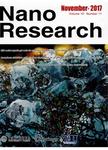Versatile multiplexed super-resolution imaging of nanostructures by Quencher-Exchange-PAINT
Versatile multiplexed super-resolution imaging of nanostructures by Quencher-Exchange-PAINT作者机构:Living Systems Institute & Biomedical PhysicsUniversity of ExeterExeter EX44QDUK Cavendish LaboratoryUniversity of CambridgeCambridge CB30HEUK
出 版 物:《Nano Research》 (纳米研究(英文版))
年 卷 期:2018年第11卷第12期
页 面:6141-6154页
核心收录:
学科分类:0808[工学-电气工程] 0809[工学-电子科学与技术(可授工学、理学学位)] 07[理学] 0805[工学-材料科学与工程(可授工学、理学学位)] 0702[理学-物理学]
基 金:supported by funding from the Human Frontier Science Program the Engineering and Physical Sciences Research Council of the UK
主 题:super-resolution microscopy fluorescence imaging DNA nanotechnology DNA-PAINT fluorescence quencher
摘 要:The optical super-resolution technique DNA-PAINT (Point Accumulation Imaging in Nanoscale Topography) provides a flexible way to achieve imaging of nanoscale structures at ∼10-nanometer resolution. In DNA-PAINT, fluorescently labeled DNA “imager strands bind transiently and with high specificity to complementary target “docking strands anchored to the structure of interest. The localization of single binding events enables the assembly of a super-resolution image, and this approach effectively circumvents photobleaching. The solution exchange of imager strands is the basis of Exchange-PAINT, which enables multiplexed imaging that avoids chromatic aberrations. Fluid exchange during imaging typically requires specialized chambers or washes, which can disturb the sample. Additionally, diffusional washout of imager strands is slow in thick samples such as biological tissue slices. Here, we introduce Quencher-Exchange-PAINT—a new approach to Exchange-PAINT in regular open-top imaging chambers—which overcomes the comparatively slow imager strand switching via diffusional imager washout. Quencher-Exchange-PAINT uses “quencher strands, i.e., oligonucleotides that prevent the imager from binding to the targets, to rapidly reduce unwanted single-stranded imager concentrations to negligible levels, decoupled from the absolute imager concentration. The quencher strands contain an effective dye quencher that reduces the fluorescence of quenched imager strands to negligible levels. We characterized Quencher-Exchange-PAINT when applied to synthetic, cellular, and thick tissue samples. Quencher-Exchange-PAINT opens the way for efficient multiplexed imaging of complex nanostructures, e.g., in thick tissues, without the need for washing steps.



